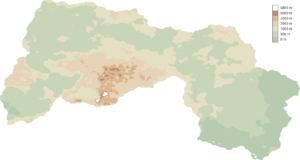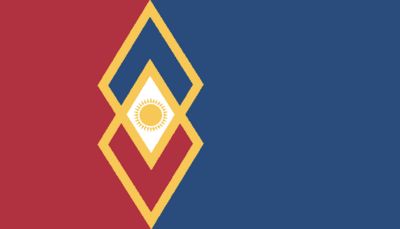Zalkent: Difference between revisions
mNo edit summary |
|||
| Line 25: | Line 25: | ||
| capital = Lesk |
| capital = Lesk |
||
}} |
}} |
||
| − | The '''Semuyic Kingdom of Zalkent,''' formerly The '''Republic of Zalkent''', is a nation located on the Firesvar continent. Following the dissolution of the [[Burr Federation]] and the subsequent end of the Burr War, the former government was plagued with economic downturn and nationwide revolts due to the devastation of the war. |
+ | The '''Semuyic Kingdom of Zalkent,''' formerly The '''Republic of Zalkent''', is a nation located on the Firesvar continent. Following the dissolution of the [[Burr Federation]] and the subsequent end of the Burr War, the former government was plagued with economic downturn and nationwide revolts due to the devastation of the war. During the year 2153, the Republican Government of Zalkent collapsed and the nation fell into a civil war that would last until 2166. Following the end of the civil war, the Ashigaru Dynasty was established.<br /> |
==Etymology== |
==Etymology== |
||
| + | The name of the nation comes from a legend that a small group of Surnic peoples told during the era of [[Kyviz-Durvek]]. That prosperity, known as "Zal", would come to the lands after times of hardship. As such, when the nation was formed, the government honored the legacy of this small legend and created the name "Zalkent".<br /> |
||
| − | <nowiki>###</nowiki> |
||
| − | <br /> |
||
==Geography== |
==Geography== |
||
<nowiki>###</nowiki> |
<nowiki>###</nowiki> |
||
| Line 41: | Line 40: | ||
==Politics== |
==Politics== |
||
===Government=== |
===Government=== |
||
| + | The government consists of two institutions, the Shogun and a cabinet along with a general assembly of elected officials. The elected officials have the power to oversee day to day tasks throughout their respective provinces and report to the Shogun, while the Shogun and the cabinet oversee foreign and domestic matters as a whole. If a situation arises that requires immediate action, an assembly is held where both insitutions meet together to discuss and set forth a course of action. The Shogun holds most of the power, although regularly differs to the elected assembly. |
||
| − | <nowiki>###</nowiki> |
||
===Subdivisions=== |
===Subdivisions=== |
||
<nowiki>###</nowiki> |
<nowiki>###</nowiki> |
||
| Line 49: | Line 48: | ||
==Demographics== |
==Demographics== |
||
===Languages and Culture=== |
===Languages and Culture=== |
||
| − | Due to her geographical location, Zalkent has been a melting pot between the cultures of other nations that she borders. This is reflected in the languages spoken and ethnic groups within the population. The larger population centers are primarily Surnic ethnicities while the Lesk capital region is primarily Fuyurikan. Following the Shogun's rise to power, some minor northern territories were added. The ethnicity within these regions primarily consists of |
+ | Due to her geographical location, Zalkent has been a melting pot between the cultures of other nations that she borders. This is reflected in the languages spoken and ethnic groups within the population. The larger population centers are primarily Surnic ethnicities while the Lesk capital region is primarily Fuyurikan. Following the Shogun's rise to power, some minor northern territories were added. The ethnicity within these regions primarily consists of Fuyurikan peoples. |
[[File:Zalkent_Culture.png|thumb]] |
[[File:Zalkent_Culture.png|thumb]] |
||
===Education=== |
===Education=== |
||
| Line 81: | Line 80: | ||
==About The Flag== |
==About The Flag== |
||
| + | [[File:Zalkent Kingdom Flag.png|thumb|400x400px|The Flag of the Ashigaru Dynasty (2166-present day)]]The design of the flag is reminiscent of the legend that the name of the nation is based on. Red represents the hardship that the people have had to go through, blue represents the brotherhood and unity that have formed between the people, with the gold representing prosperity. The star represents strength, willpower, and light that emanates across the nation. |
||
| − | [[File:Zalkent Kingdom Flag.png|thumb|400x400px]] |
||
| + | |||
| + | Following the collapse of the Republican government and the establishment of the Ashigaru Dynasty, the Semuyic religious symbol was added to the flag, along with white which represents divinity. |
||
[[Category:KP2.5 Nations]] |
[[Category:KP2.5 Nations]] |
||
[[Category:KP3 Nations]] |
[[Category:KP3 Nations]] |
||
Revision as of 01:11, 23 January 2024
|
Semuyic Kingdom of Zalkent
Semuyskiy Kyohōkoku Zalkentaya
|
|||||
|---|---|---|---|---|---|
 |
|||||
| Motto | "Forward Towards Prosperity!" | ||||
| Common Name | Zalkent | ||||
| Anthem | The Last Flight - Lucas Ricciotti | ||||
 |
|||||
| Demonym | Zalkentian | ||||
| Official languages | Fuyurikan, Sarchak | ||||
| Currency | Zalkentian Muira | ||||
| Politics | |||||
| Capital | Lesk | ||||
| Government | Dynastic Constitutional-Shogunate | ||||
| Foundation | 2137 - 2150s (Republican Government) 2160s (Current Government) | ||||
| Shogun | Masahiro Ashigaru | ||||
| Preceded by | Kyviz-Durvek, Burr | ||||
| Demography | |||||
| Ethnicities | 77.0% Surnic 23.1% Fuyurikan | ||||
| Population | 3,068,343 | ||||
| Area | 35,978 km² | ||||
The Semuyic Kingdom of Zalkent, formerly The Republic of Zalkent, is a nation located on the Firesvar continent. Following the dissolution of the Burr Federation and the subsequent end of the Burr War, the former government was plagued with economic downturn and nationwide revolts due to the devastation of the war. During the year 2153, the Republican Government of Zalkent collapsed and the nation fell into a civil war that would last until 2166. Following the end of the civil war, the Ashigaru Dynasty was established.
Etymology
The name of the nation comes from a legend that a small group of Surnic peoples told during the era of Kyviz-Durvek. That prosperity, known as "Zal", would come to the lands after times of hardship. As such, when the nation was formed, the government honored the legacy of this small legend and created the name "Zalkent".
Geography
###
Climate
###
Biodiversity
###
Urban Areas
###
Politics
Government
The government consists of two institutions, the Shogun and a cabinet along with a general assembly of elected officials. The elected officials have the power to oversee day to day tasks throughout their respective provinces and report to the Shogun, while the Shogun and the cabinet oversee foreign and domestic matters as a whole. If a situation arises that requires immediate action, an assembly is held where both insitutions meet together to discuss and set forth a course of action. The Shogun holds most of the power, although regularly differs to the elected assembly.
Subdivisions
###
Foreign Relations
###
Demographics
Languages and Culture
Due to her geographical location, Zalkent has been a melting pot between the cultures of other nations that she borders. This is reflected in the languages spoken and ethnic groups within the population. The larger population centers are primarily Surnic ethnicities while the Lesk capital region is primarily Fuyurikan. Following the Shogun's rise to power, some minor northern territories were added. The ethnicity within these regions primarily consists of Fuyurikan peoples.
Education
###
Religion
###
Age
###
Military
Air Force
The Zalkentian Air Forces (ZAF), is currently one of the most advanced and well equipped parts of the Zalkentian Military post civil war. Comprised of a presently unknown amount of fighter squadrons, each of which are primarily tasked with the defense of Zalkent and her borders along with the defense of allied nations.
Army
Economy
Taxation
###
Transport
###
Energy and Infrastructure
###
Trade
###
Science
###
History
Notable Events
About The Flag
The design of the flag is reminiscent of the legend that the name of the nation is based on. Red represents the hardship that the people have had to go through, blue represents the brotherhood and unity that have formed between the people, with the gold representing prosperity. The star represents strength, willpower, and light that emanates across the nation.
Following the collapse of the Republican government and the establishment of the Ashigaru Dynasty, the Semuyic religious symbol was added to the flag, along with white which represents divinity.


